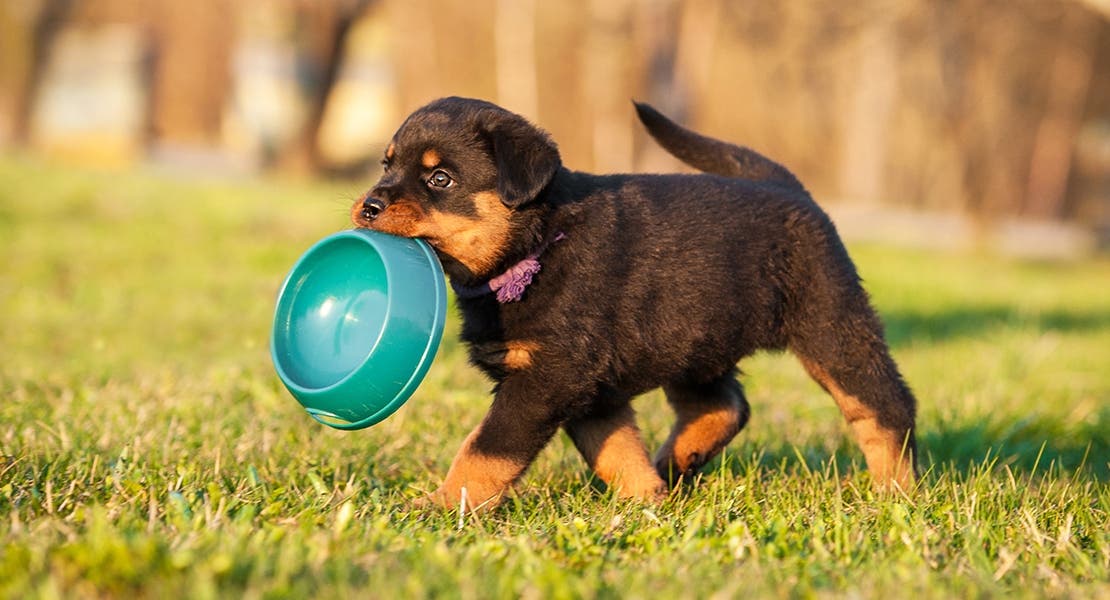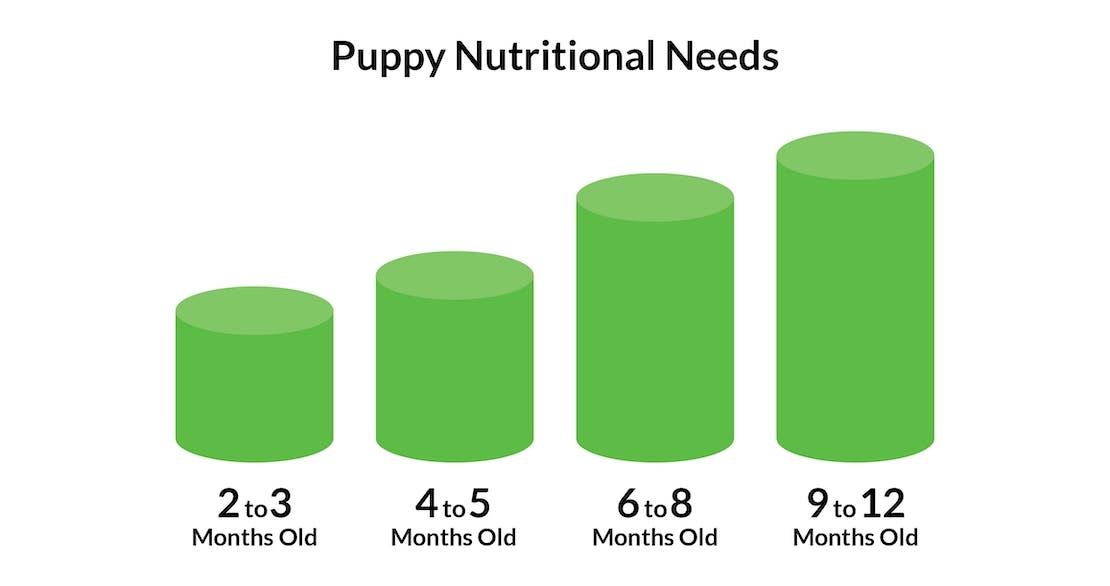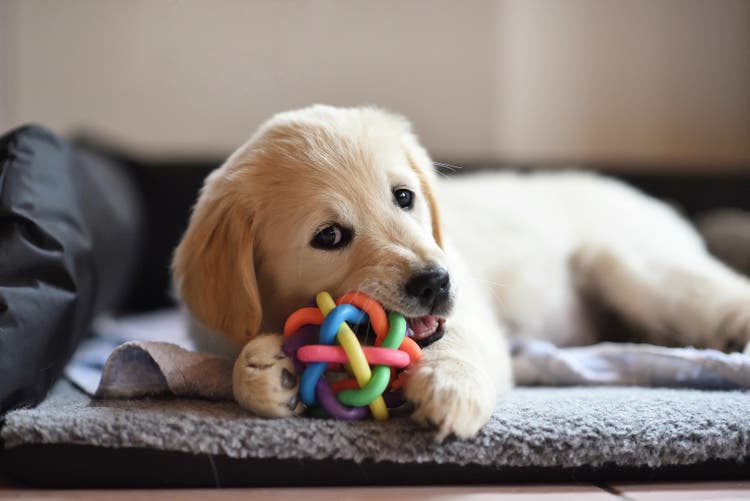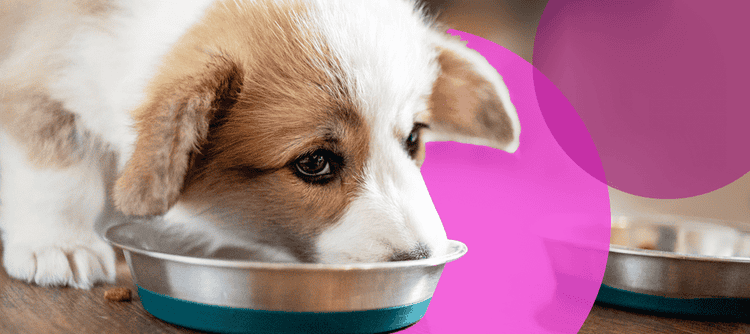Get our guide to feeding a new puppy.
Your puppy has specific nutritional needs that can vary by their breed. Here's what you need to know about when your puppy should start eating food, how much you should feed them and when to transition them from puppy food to adult dog food.
When Do Puppies Stop Nursing?
Puppies are weaned at about 6 to 8 weeks of age. They should begin eating puppy-specific dry kibble or wet food as soon as they are weaned.
What Should You Feed a Puppy?
Always feed your puppy food specifically formulated for puppies. Your puppy's needs can vary depending on size, so choose a large- or small-breed formula if appropriate. Small-breed food is usually smaller in size and higher in caloric density, while large- and giant-breed food typically is not as calorie-rich and supports slower growth rates to prevent skeletal issues.
No matter the breed it's intended for, balanced puppy food should contain the following nutrients:
- Protein to support muscle development and a healthy immune system
- Fats for energy
- Calcium to develop teeth and bones
- Docosahexaenoic acid (DHA) , an omega-3 fatty acid, to support healthy brain and vision development
How Much Should You Feed a Puppy?
The amount of food a puppy needs should be based off the feeding instructions on the specific food's packaging. It's important to follow a pet food's specific feeding directions, which are typically found on the back of the packaging.

Puppy Feeding Chart1
Below is an example of what a feeding guide generally looks like for a growing puppy. As all dog foods vary, always feed your dog according to the specific instructions provided on their current food or speak to a veterinarian.
Adult Weight: 3 to 12 Pounds
- Up to 3 months: ½ to 1 cups
- 4 to 5 months: ⅔ to 1⅓ cups
- 6 to 8 months: ½ to 1½ cups
- 9 to 11 months: Feed as Adult
- 1 to 2 years: Feed as Adult
Adult Weight: 13 to 20 Pounds
- Up to 3 months: ½ to 1¼ cups
- 4 to 5 months: 1⅛ to 2 cups
- 6 to 8 months: ¾ to 1⅓ cups
- 9 to 11 months: 1 to 1½ cups
- 1 to 2 years: Feed as Adult
Adult Weight: 21 to 50 Pounds
- Up to 3 months: ½ to 1½ cups
- 4 to 5 months: 1½ to 2¾ cups
- 6 to 8 months: 1⅛ to 2⅓ cups
- 9 to 11 months: 2 to 3 cups
- 1 to 2 years: 2 to 4¼ cups
Adult Weight: 51 to 75 Pounds
- Up to 3 months: ⅝ to 2⅓ cups
- 4 to 5 months: 1½ to 4 cups
- 6 to 8 months: 1½ to 3¾ cups
- 9 to 11 months: 2½ to 4¾ cups
- 1 to 2 years: 2⅝ to 6¼ cups
Adult Weight: 76 to 100 Pounds
- Up to 3 months: 1 to 2⅔ cups
- 4 to 5 months: 2⅞ to 3¾ cups
- 6 to 8 months: 2⅞ to 6⅓ cups
- 9 to 11 months: 3⅞ to 7 cups
- 1 to 2 years: 5⅝ to 11 cups
Adult Weight: 100 and above
- Up to 3 months: 2⅔ cups + ⅓ cup for each 10 pounds of body weight over 100 pounds
- 4 to 5 months: 3¾ cups + ⅓ cup for each 10 pounds of body weight over 100 pounds
- 6 to 8 months: 6⅓ cups + ⅓ cup for each 10 pounds of body weight over 100 pounds
- 9 to 11 months: 7 cups + ⅓ cup for each 10 pounds of body weight over 100 pounds
- 1 to 2 years: 11 cups + ⅓ cup for each 10 pounds of body weight over 100 pounds

The graphic above illustrates how the amount of food a growing puppy needs increases as they reach adulthood. Always check the label of your puppy's food for specific feeding requirements.
As always, consult your veterinarian if you are unsure about the amount you should feed your puppy.
How Often Should You Feed a Puppy?
It's best to feed your puppy at regular times in regular amounts. Make sure to read the feeding instructions on the food's packaging, but a good rule of thumb is:
- Under 3 months old: four meals per day
- 3 to 6 months old: three meals per day
- 6 months old and up: two meals per day
How Do You Know If a Puppy Is Getting Enough Food?
All puppies grow at different rates, but your puppy should be growing noticeably and steadily, especially in the first five or six months. If your puppy is lethargic, or has a dull coat or eyes, it could mean they need a different food - or even that the puppy may have intestinal worms. If this is the case, reach out to your veterinarian to discuss finding a different food or deworming your puppy.
Can You Feed a Puppy Treats?
Treats are an important training tool for puppies, as well as a good way to bond with your pet. The number of treats you give should be no more than 10% of the total amount of food your puppy eats in a given day. Never give your puppy chocolate, cinnamon, macadamia nuts, grapes or any food containing allium (garlic, onions, leeks, chives), as these can be toxic.
When Can a Puppy Start Eating Adult Dog Food?
Puppies reach maturity at different ages, depending on breed. Some dogs - mainly large breeds - might need to stay on puppy food for up to 24 months after weaning, while others can begin eating adult dog food at 1 year of age. Talk to your veterinarian for the right timing, especially if you have a large-breed puppy.
Always introduce a new food gradually, starting by replacing 10% of the puppy food with the new adult dog food and slowly increasing the percentage of adult food. Depending on your dog's tolerance for diet changes, this shift should take about a week.
Feeding your puppy the right amount at the right times is just one factor in their overall health and happiness. Learn more about whether your puppy is growing at a healthy rate, how to stop your puppy from nipping and how to get them to sleep through the night.
References
1. How Much Should I Feed My Puppy? A Complete Puppy Feeding Guide with Chart. (n.d.). Retrieved June 23, 2020, from https://www.purina.com/articles/puppy/feeding/how-much-to-feed-a-puppy-chart
Related Articles

Puppy Parenting: Our Downloadable Guide
New puppy? Whether this is your first go-round or your fifth, we know that so much goes in to raising healthy, happy pups. Check out our free guide, also available to download!







